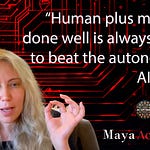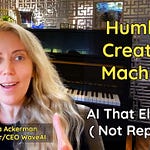Once upon a time, the 2023 Writers Guild of America (WGA) strike, which lasted from May 2 to September 27, 2023.
Poised against AI with shows/movies delayed, a truce was reached. Seemed like the creatives won….
This week the announcement: Academy AI-assisted films can win Oscars - surprise.
When Adrien Brody won Best Actor for The Brutalist this year, few people knew AI had enhanced his Hungarian accent.
The Oscar-winning musical Emilia Perez used voice-cloning to improve singing performances.
And the Academy's new rules specifically state they'll still "consider human involvement when selecting winners."
All that hot air out of Hollywood about fighting AI and then bringing it together is simply the way AI is working out.
And you need to follow the trails that are out there. Not the trends, not the PR trends, but what's happening.
If you're a creator trying to use your skills in this new world of AI without getting replaced, or a developer trying to find richer sources of data, you're all looking for something that we think is IQ, but it's actually HQ – the Human Quotient.
In a world obsessed with artificial intelligence, HQ matters more.
By the end of this post, you'll not only understand what HQ stands for, but you'll see why it's becoming the most valuable creative currency in the AI age.
Deep Thinking - The Long Game
We've all seen AI write a paragraph or generate an image in seconds. Here's what it can't do: understand the creative journey behind something like Star Wars.
Sure, AI might have scraped the Star Wars script somewhere in its training data. But having the script is just having the final product - not the experience that created it.
What AI can't access is George Lucas editing with his wife, who helped shape the film critically.
It can't know which scenes bombed with test audiences and which worked.
It can't feel what the actors felt shooting a movie they thought looked hokey, waiting for Lucas to create a cantina full of aliens that would take another 20 years to properly realize.
AI hasn't experienced Lucas's deep dive into Joseph Campbell's mythologies, his decision to essentially make a Western in space with good guys in white and bad guys in black.
All that invisible context - that's the deep-thinking AI can't replicate.
A novelist might describe the gap:
"AI can access my published words, but it can't access my notebook
where I spent months mapping connections.
That's where real magic happens."
Deep thinking is AI proof.
The novelist knows that AI can access published words, but it can't access this notebook - the months of thinking that makes the story work.
The ability to maintain coherent structure over long works isn't just another skill. It's a human advantage.
For developers, better AI isn't just about more data. It's about understanding how humans plan and structure experience over time.
Here’s how to start:
Document your creative process, not just your final product -- journals, notes, and behind-the-scenes footage are becoming as valuable as the work itself
If you're a developer, look beyond content scraping -- partner with creators willing to share their thinking process, not just their finished work
Create structured thinking frameworks in your field -- the ability to maintain coherence over long projects is distinctly human and increasingly valuable
Emotional Resonance - The Feeling Beyond the Words
Is it funny if AI cracks a joke and no one laughs?
This gets at our second HQ element - emotional resonance.
The BBC recently organized professional comedians to test AI humor generation. They found AI could structure monologues or help with writer's block, but the actual jokes?
The comedians called them bland and generic. Why?
Because AI has never bombed on stage. It's never felt the rush of making a room laugh or the crushing silence of a joke falling flat.
A comedian named Anesti Danelis took this challenge head-on, incorporating AI-generated material into his live show.
He found the AI could generate joke structures, but it couldn't understand timing or read a room - the essence of comedy.
Colleen Lavin, a developer and comedian who participated in another study, designed a standup routine where if the audience didn't laugh at her jokes, she would get heckled by AI, creating that interactive experience.
This real-time emotional feedback loop is exactly what AI needs but can't generate itself.
Giving AI a little emotional intelligence boost:
Create feedback loops with real humans -- whether it's testing comedy, designing products, or building systems, nothing replaces genuine human reaction
Connect your work to authentic personal experiences -- specificity from lived experience creates emotional depth
If you're developing AI systems, focus on emotional response tracking -- the most valuable AI will be one that recognizes when humans are connecting emotionally, even if it can't feel emotions itself
Cultural Wisdom - The Context Beyond the Content
While everyone's chasing the same AI tools, what's becoming scarce is perspective - particularly from cultures whose stories don't follow the patterns AI was trained on.
Many tribes in America tell stories using circular or non-linear structures that fundamentally differ from the Western beginning-middle-end format dominating AI training data.
The Diné (Navajo) use Story Circles, where the physical arrangement of storytellers in a circle reflects their non-linear approach to narrative.
The Anishinaabe tradition uses Spiraling or Layered Narratives, where stories revisit themes or events, deepening understanding with each retelling rather than progressing linearly.
And many storytelling traditions connect to natural cycles - seasons, stars, and animal migrations - structuring narratives through relationship with the environment rather than human-centered plot.
AI only knows stories with beginnings, middles, and ends. These don't work that way - and that makes them valuable.
What if you listened to tribes around the Great Lakes?
The Anishinaabe way of storytelling teaches to respect life from the smallest insects up and focuses on the kind of conduct people show to each other.
These moral lessons tie into the seasons and look beyond time, creating interconnections with what came before and what is coming now.
These storytelling traditions are rich sources of data. Working with different cultures could not only create more nuanced AI systems but also support amazing causes around the world, helping communities preserve their languages and teach them to the next generations.
Here's how to apply cultural wisdom to your creative work:
Look beyond dominant cultural frameworks -- whether you're creating content or building AI, alternative perspectives create value precisely because they're underrepresented
Partner across cultural boundaries -- the most innovative work happens at the intersection of different worldviews
If you come from an underrepresented background, position your perspective as a strength -- your unique cultural viewpoint is valuable for expanding what's possible in your field.
The Human Quotient: Our Most Valuable Creative Currency
So what is this mysterious HQ factor?
It stands for Human Quotient - the degree to which creative work contains elements that only come from lived human experience: deep thinking processes, emotional resonance, and cultural wisdom.
This is why the Academy's rule about considering "human involvement" matters so much.
They understand what we've been exploring: in a world where AI can generate endless content but can't experience anything, the Human Quotient becomes the scarcest and most valuable resource.
It's not about whether AI should or shouldn't be used in creative work - that ship has sailed.
It's about recognizing that human experience is what gives creative work its depth and meaning. For creators, this means focusing less on what you make and more on the human experience you bring to it.
For developers, it means building systems that value and incorporate human experiential intelligence.
I'm not trying to compare this and say AI is all great and give it a big hug. I want creators to understand that they have immense value and that what they have is AI-proof.
Experience - until those robots start walking around and getting impacted by life as they grow up, they're not going to have that.
This isn't just theoretical - it's happening now as certain types of creative work become more valuable in the AI age, not less.
Not because of magical opportunities, but because what we feel, know, and understand as humans can never be fully captured in data alone.
The more you mix it up, the smarter the output.
I don't know many people who truly understand both sides of this equation, and usually the ones I've met are either engineers or creators.
It's part of why I'm trying to bring both together - not personally, but because I think together we could create something masterful.
It's not artificial intelligence. It's our human experience and intelligence looking at us and saying,
“Hello, let's tell a story a different way. Let's go deeper and get better data."
Being human isn’t going out of style, despite what AI zealots share.
Maybe AI is helping us discover what being human is all about.
RESOURCES
Films made with AI can win Oscars, Academy says
What 'The Brutalist’ and 'Emilia Pérez' AI Controversy Means for the Oscars
The Brutalist’s AI Controversy, Explained
Hollywood’s AI issues are far from settled after writers’ labor deal with studios
What happened when 20 comedians got AI to write their routines
No laughing matter - how AI is helping comedians write jokes
An AI walks into a bar... Can artificial intelligence be genuinely funny?


















